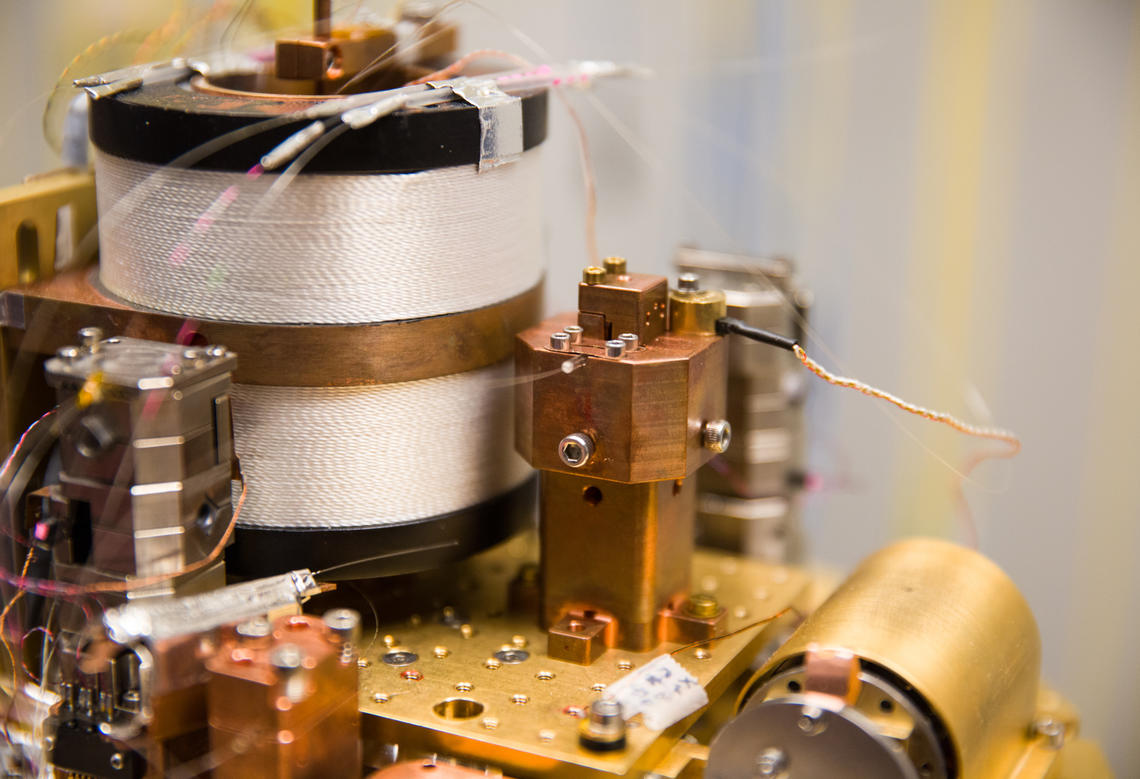Oct. 13, 2017
Faculty of Science physicists link billions of atoms in very large quantum entanglement

University of Calgary Faculty of Science quantum physicists along with colleagues in Ottawa and the United States have linked, or entangled, a record-breaking number of groups of atoms at the quantum level.
The research team’s experiment demonstrated “macroscopic” quantum entanglement in a solid crystal of more than 200 systems, or ensembles, of atomic particles. Each ensemble comprised about one billion atoms.
“It’s a very big entangled state by any measure, one of the largest number of systems ever entangled,” says Christoph Simon, professor in the Department of Physics and Astronomy.
The research provides more understanding of quantum entanglement, including techniques for creating ever-larger entangled states in “quantum memories for light” devices. This could lead to technologies such as quantum sensors, highly secure quantum encryption for communications, and quantum repeaters linking quantum computers in a network.
“We showed the possibility of entangling hundreds of macroscopic atomic ensembles, something that hasn’t been done before,” says Wolfgang Tittel, professor in the Department of Physics and Astronomy and Alberta Innovates Technology Futures Strategic Chair in Quantum Secured Communication. “The more we understand the properties of entanglement, and the better we master showing these properties in the laboratory, the better will be the technology that arises out of entanglement.”
The team’s research is published in Nature Communications, one of the top-ranked Nature series of scientific journals. In separate work published simultaneously, researchers from Geneva showed quantum entanglement of 16 million atoms, using a similar experimental approach.
Nine graduate students and post-doctoral researchers from Simon’s and Tittel’s group worked on the experiment.
- Pictured above, some of the team, from left: Daniel Oblak, Christoph Simon, Parisa Zarkeshian, Marcel.li Grimau, Wolfgang Tittel, and Pascal Lefebvre.

The researchers used a state-of-the-art photon detector in their work.
Riley Brandt, University of Calgary
Experiment intricately designed
Quantum entanglement is a strange yet fundamental phenomenon in quantum physics that scientists have observed and measured. Through entanglement, seemingly independent particles become intertwined and, when measured, can instantaneously affect each other’s behaviour even if separated by a distance.
Unlike in classical physics, “you can’t describe the state of the whole system in terms of the state of its parts,” Simon says. “You have to think of it as a whole.”
In their experiment, the team sent single photons, or particles of light energy, through a crystal interspersed with ions of thulium, a rare earth element. The researchers modified the atoms inside the crystal using a laser beam, creating a well-ordered structure called an atomic frequency comb. It has many peaks or comb-like "teeth" of atomic particle ensembles that absorb the photon, each at slightly different frequencies. As the single photons travelled through the crystal, they were collectively absorbed by many rare-earth ions at once, entangling them.
“It is fundamentally not determined which of the atomic ensembles absorbs the proton,” Simon explains. “That is the quantum entanglement.”
How far apart the frequencies are determines the time the photon is re-emitted from the crystal — in tens of nanoseconds. The approach is akin to a well-known elementary physics experiment in which a beam of light is shone through many slits to show diffraction. The direction in which light is observed behind the slits corresponds, in the team’s experiment, to the time at which photons can be emitted by the atomic frequency comb.
The researchers used a state-of-the-art photon detector to record each photon being re-emitted. By precisely measuring the fraction of photons being re-emitted at the correct re-emission times, the team was able to calculate how many quantum systems and billions of atoms became entangled.
“That number was really high because we pushed our lab capabilities at creating these atomic frequency combs and measuring the photons with much less signal 'noise' than previously,” Tittel notes.
Collaboration was key to success
Simon’s research group led development of the theory and mathematical proof for the work, while Tittel’s group performed the experiment at UCalgary. Both researchers are members of the university’s Institute for Quantum Science and Technology. Colleagues from the National Institute of Standards and Technology in Boulder, Colorado, and from the Jet Propulsion Laboratory at the California Institute of Technology, designed and built the photon detectors.
A total of nine graduate students or post-doctoral researchers from Simon’s and Tittel’s group worked on the experiment. They included Parisa Zarkeshian, a PhD student and first author on the paper, who did much of the theoretical work. Neil Sinclair, a post-doctoral scholar who spearheaded implementing the experiment, and Simon conceived the idea, with some input from Tittel.
“It was the collaboration between students, post-docs and senior people in both groups that made it all work,” Tittel says.
Major funding for the research came from the Natural Sciences and Engineering Research Council of Canada, Alberta Innovates Technology Futures and the U.S. Defense Advanced Research Projects Agency.
